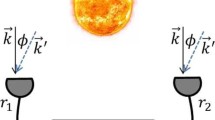Abstract
In order to study an original detection architecture for future cosmology experiments based on wide band adding interferometry, we have tested a single baseline bench instrument based on commercial components. The instrument has been characterized in the laboratory with a wide band power detection setup. A method which allows us to reconstruct the complete transfer function of the interferometer has been developed and validated with measurements. This scheme is useful to propagate the spurious effects of each component till the output of the detector.







Similar content being viewed by others
Notes
Here ideal means \(T_{m}=1-2\sin\left(\frac{2\pi\delta}{\lambda}+\Delta\alpha\right)\).
Centre des Etudes Spatiales du rayonnement.
Centre National de la Recherche Scientifique.
References
A. Tartari et al., Brain/mbi: A Bolometric Interferometer Dedicated to the cmb Polarization, 5th ESA Workshop on Millimetre Wave Technology and Applications, Vol. WPP-300, (ESA, 2009).
A. R. Thompson, J. M. Moran, and G. W. Swenson, Interferometry and Synthesis in Radio Astronomy (Wiley-Interscience, New York, 1986), 554 p.
D. M. Pozar, Microwave Engineering (John Wiley & Sons, 1998).
Acknowledgements
This work has been done in the frame of the QUBIC collaboration, the CNESFootnote 2/CNRSFootnote 3 PhD funding for A. Ghribi and Mairie de Paris Post-doc funding for A. Tartari. This instrument has been funded by Programme AstroParticule of CNRS in France. Special thanks to Alessandro Baù and Andrea Passerini for helping us in solving technical problems.
Author information
Authors and Affiliations
Corresponding author
Appendix
Appendix
We consider here a two ports device. The source generator is connected to port 1 and a matched load to port 2. We then have an incident wave \(V_{1}^{+}\) to the DUT (Device Under Test). The wave reflected from the device back to port 1 is \(V_{1}^{-}\). The signal traveling through the DUT and toward port 2 is \(V_{2}^{-}\). Any reflection from the load is \(V_{2}^{+}\).
We can express the transient E field in term of voltages as in [3]:
where e(x,y) is the variation of the amplitude of the field propagating inside a waveguide section and c is a geometrical parameter. These variables are set to constants because of the common waveguide shape along the chain (cascade of components). E 1 and E 2 are the fields in the input and in the output of the device and β 1 and β 2 are their respective phases. In order to express E2 with E1, we need to consider the same base (the same propagation direction of the wave). Let’s set the propagation from port 1 to 2 as positive and from 2 to 1 as negative. This gives
with β 2′ = − β 2.
Finally, expressing E 2 in terms of E 1 and using the S parameters definition as in [3], we obtain:
Rights and permissions
About this article
Cite this article
Ghribi, A., Tartari, A., Bréelle, E. et al. Experimental Study of an Adding Interferometer at Millimeter Waves. J Infrared Milli Terahz Waves 31, 88–99 (2010). https://doi.org/10.1007/s10762-009-9562-y
Received:
Accepted:
Published:
Issue Date:
DOI: https://doi.org/10.1007/s10762-009-9562-y




